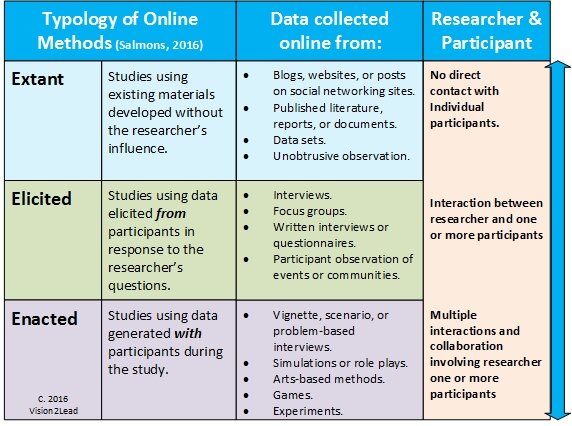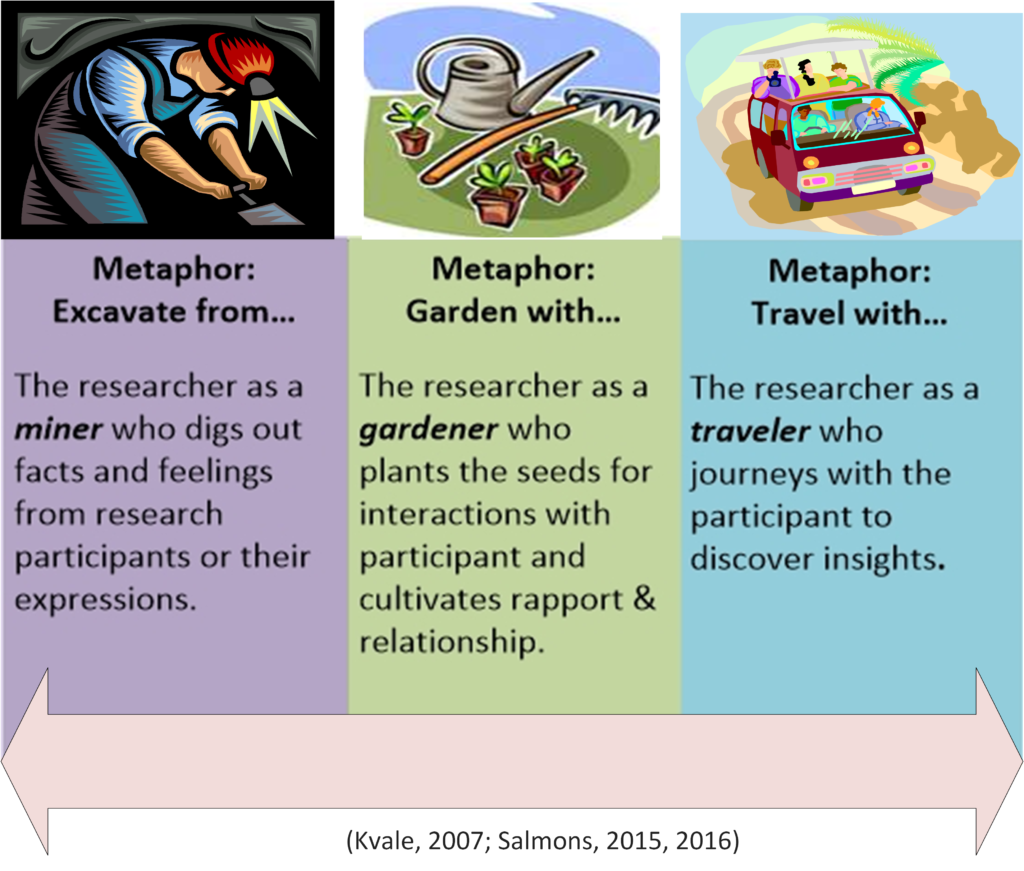Metaphors for Thinking about Qualitative Researchers’ Roles
The focus for January is on researchers’ roles, including characteristics and skills critical to success. Read the whole series here.
The roles we take as researchers vary greatly depending on the nature of the study. One pretty clear distinction is between studies where the researcher interacts directly with participants, and studies where the researcher relies on extant data. In Doing Qualitative Research Online I differentiated three types of qualitative data collection as Extant, Elicited, and Enacted.
Extant datawas created for a purpose outside of our research, and collecting it does not entail direct interaction with those who created the images, documents, or datasets. When you start asking questions, you move to elicitation methods. Elicited data is collected when we interview or otherwise engage with consenting participants. Sometimes we go beyond asking questions, and for those highly interactive approaches I use the term enacted research. While I was focused specifically on ways to collect data online, these principles apply more generally.
What roles do researchers take in these three types of qualitative data collection?
One way to think about roles is through the stances taken by the researcher, which I describe metaphorically as the miner, traveler and gardener (Salmons, 2010, 2015, 2016).
According to the metaphors Kvale and Brinkman (Kvale, 2007; Kvale & Brinkman, 2014) devised to explain various roles that interviewers take, the researcher who digs out facts and feelings from research subjects is characterized as a miner. The traveler journeys with the participant to experience and explore the research phenomenon. I introduced the metaphor of the gardener to suggest a nurturing process that is often needed when building rapport with participants online. The metaphor alludes to ways a researcher uses questions or prompts to plant a seed and follow-up or probing questions to cultivate the growth of ideas and shared perceptions. Matching metaphor to methods is not cut-and-dry, and certainly a researcher might take more than one role in a given study. But there are some natural fits.
Extant research is clearly aligned with the metaphor of the miner. The researcher locates potentially rich seams and starts digging. Today’s researchers have many options for using extant resources including historical or contemporary documents, images, or datasets (Salmons, 2019). Researchers might use diary, narrative, or visual or text analysis methods with enacted data. However, since this type of researcher does not influence the substance or nature of the data, using only what has been posted or curated, the researcher may find that the extant data is not adequate to achieve the purpose of the study. In a multimethod study the researcher could add an interview or questionnaire component to the study and elicit explanations from participants to fill in missing pieces of the story.
Elicited research is most appropriately aligned with the gardener metaphor. The researcher may use verbal or written questions to elicit responses to interviews or focus groups. In a study using participant observation, the researcher may elicit data by informally asking questions or conversing with others engaged in the activity under observation. Researchers using these methods may also use images, graphics or media that represent some aspect of the research problem or phenomenon to elicit reactions or answers. Elicitation is flexible and, unlike the researcher using extant data, researchers can draw out detailed replies specific to the phenomena being studied.
Researchers using enacted research approaches fit the metaphor of the traveler. For this kind of study researcher designs and carries out events or activities that require the researcher to be a co-participant. Rather thank thinking about collecting data, data is generated through research events. Creative and arts-based methods, simulations, games, action research or field experiments are some of the highly-interactive methods used. The researcher is highly engaged with the participant(s) throughout multiple stages of the study.
When you think about the type of qualitative study you want to design, think about the roles you prefer to take, and the ways you will relate to participants or materials. How might your preparation change depending on whether you will be a miner, gardener, or traveler? How might you prepare your students or doctoral mentees to take these roles?
Kvale, S. (2007). Doing interviews. Thousand Oaks: SAGE Publications.
Salmons, J. (2015). Qualitative online interviews. Thousand Oaks: SAGE Publications.
Salmons, J. (2016). Doing qualitative research online Doing qualitative research online. London: SAGE Publications.
Salmons, J. (2019). Gather your data online. London: SAGE Publications.
Read more!
Doing Qualitative Research Online is now available in the SAGE Research Methods database. If your library doesn’t have a subscription, and you would like to access the materials listed here, explore SAGE Research Methods with a free trial.


